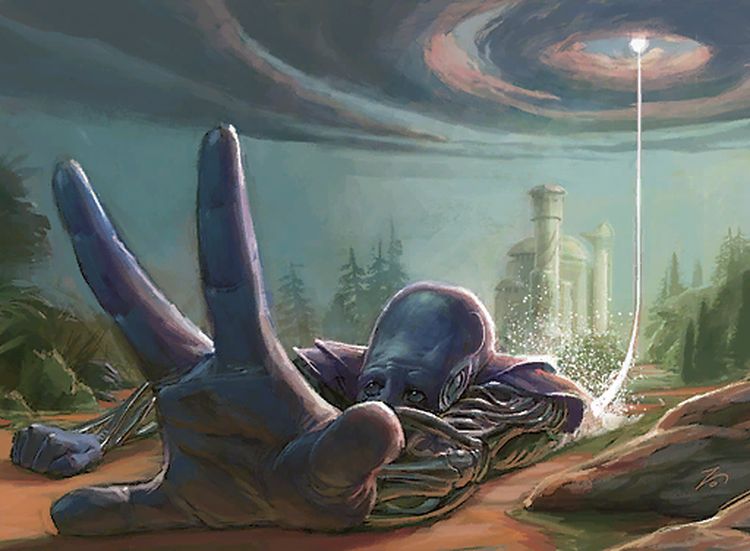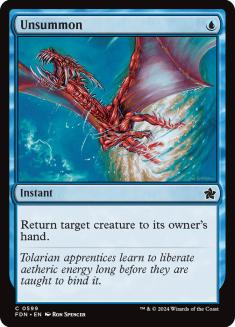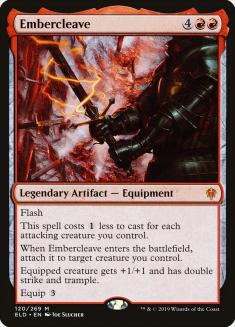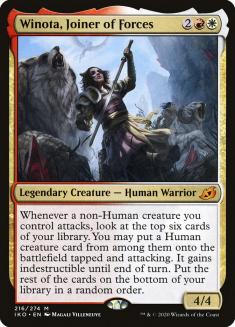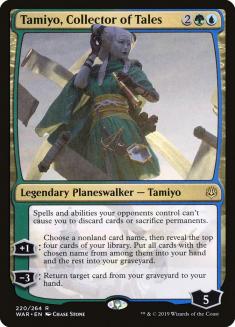Back when Delver of Secrets and Snapcaster Mage were legal in Standard, everyone played Vapor Snag. It was so good that people started wondering if we’d been wrong to ignore Unsummon, which had been around since Alpha all these years.
After Core Set 2013 Unsummon took a break from Standard, and it never really reappeared in decklists when it came back in Hour of Devastation or Core Set 2020. With the banning of Teferi, Time Raveler and Wilderness Reclamation from Standard, I think it might be time for Unsummon to make a comeback.
Unsummon’s strength is its versatility. It’s a one-mana instant, so it’s very easy to leave mana up to cast it whenever it’s at its best. Teferi, Time Raveler took away a lot of the power of Unsummon. Directly, it meant that you couldn’t use it to save your creature in response to anything while Teferi was on the battlefield.
Beyond that, Teferi generally reduced the number of tricks people played by disabling instants, and also decreased the number of Auras and expensive creatures people played by creating a format where people could expect that their creatures would be bounced regularly. Without Teferi your Unsummon is less likely to lose utility, more likely to effectively counter your opponent’s instant, and more likely to have a high-value target to bounce.
Wilderness Reclamation was a powerful deck where the few creatures it played weren’t really the point, and it served to minimize the amount of removal players could get away with running; removal couldn’t meaningfully interact with their gameplan, and if you weren’t interacting you needed to be ending the game.
Wilderness Reclamation’s banning should result in a format with greater focus on creatures, which in turn will lead to more removal spells seeing play. Unsummon can interact with both creatures and removal spells, so it’s best in a format where more of both are played.
Both of those cards leaving substantially increases the appeal of Unsummon in Standard, but the case goes beyond that.
Some of the most-hyped remaining cards are Embercleave and Winota, Joiner of Forces.
Unsummon is obviously great against both of these cards, but beyond that, it’s uniquely good against them. Winota is consistently paired with Selfless Savior, which is both a cheap non-Human to trigger Winota and a shield to make sure you get a full combat with Winota if your opponent has a removal spell, but it can’t stop Unsummon. Against Embercleave, it’s only exceptional because the red deck is so fast and one-mana removal is so hard to come by in Standard.
That’s the other point. You make be thinking, “Yeah, we know bounce is good. We’ve all been playing Petty Theft,” but that’s just it. Standard is absolutely full of two-mana removal. There are dozens of ways to answer a permanent for two mana, many of which are more powerful and versatile than most similar cards in Magic’s history, but a single mana doesn’t get you very far in today’s Standard, and that’s where Unsummon offers something unique.
So maybe you’re open to the idea that Unsummon could have a place in Standard, but you’re still wondering what that place is. Let’s explore.
Historically, Unsummon has been at its best in mono-blue and Simic decks, with occasional use in Izzet or Azorius decks. I believe this is no exception.
The first use I want to call attention to is Unsummon with Uro, Titan of Nature’s Wrath. As a card advantage engine, Uro can easily forgive the card disadvantage inherent in many uses for Unsummon, and as a cheap instant, Unsummon helps fuel Uro.
By default, Uro plays well with cheap interaction, so that’s a good baseline, but the neat thing about Unsummon specifically is that in matchups or draws where removal isn’t what you want, you can cast Uro from your hand and stack the triggers to play an Island and Unsummon your Uro before sacrificing it, turning your Unsummon into an additional Explore effect. Obviously this isn’t Plan A, but it’s a nice failsafe that other interactive spells wouldn’t offer.
Unsummon is a great way to capitalize on a tempo advantage, which makes it strong in proactive decks, but that’s not really the best place for Uro, so what does the rest of the deck look like when we try to combine these cards? Well, the other place where Unsummon is strong is when it’s converting a card advantage engine into an efficient impact on the battlefield. This means Unsummon plays very well in decks where you want to protect planeswalkers, trading the card for further activations.
Tamiyo, Collector of Tales is a particularly great fit here, since it plays so well with Uro, and Unsummon is a remarkably strong card to be able to return with Tamiyo’s -3 ability because it provides a uniquely efficient effect.
As to the best way to flesh out the rest of the deck beyond those three cards, I’m honestly not sure. They provide a strong core that can easily support a third color, but to my mind, where to go with this shell is an open question.
Creatures (17)
- 3 Hydroid Krasis
- 4 Cavalier of Thorns
- 1 Brazen Borrower
- 3 Uro, Titan of Nature's Wrath
- 4 Llanowar Visionary
- 2 Jolrael, Mwonvuli Recluse
Planeswalkers (7)
Lands (26)
Spells (10)

This deck’s plan is to use Unsummon and Brazen Borrower to buy time to lock down the battlefield with Cavalier of Thorns and Hydroid Krasis, and then win either by attacking with those and Uro or achieving a Jace, Wielder of Mysteries kill, with Tamiyo providing reliable access to the one copy of Jace.
These creatures are large enough to turn the corner against most aggressive decks, but there are decks that generate battlefields that go over the top of the creatures this deck can produce, and that’s where this deck leans on Ugin, the Spirit Dragon out of the sideboard. It’s possible, depending how the metagame shapes up, that Ugin should be in the maindeck. It’s also possible that a similar effect could be produced with a few Fae of Wishes.
While I think Unsummon can be a valuable role-player in a deck like this, I think it really shines in more aggressive decks.
Mono-Green Aggro has been a successful strategy in Standard and could become even more popular, as nothing from that deck was banned. Early in the evolution of Pioneer, we saw Mono-Green Aggro shift to Simic Aggro to include cards like Stubborn Denial and Oko, Thief of Crowns. While we don’t have cards on that power level in Standard, a blue splash can play well in aggressive green decks that can use the tempo advantage from a card like Unsummon and generally appreciate access to something like Negate in the sideboard.
Creatures (29)
- 4 Scavenging Ooze
- 4 Pelt Collector
- 2 Paradise Druid
- 4 Barkhide Troll
- 4 Lovestruck Beast
- 4 Questing Beast
- 4 Stonecoil Serpent
- 3 Gemrazer
Planeswalkers (2)
Lands (24)
Spells (5)
Sideboard

This is a typical aggressive green deck with Unsummon replacing some of the removal, which offers Aether Gust and Negate in the sideboard. The blue mana isn’t trivial, so Paradise Druid is included to help out a bit. Yorvo, Lord of Garenbrig is excluded to minimize the pain of basic Island, and Questing Beast is maximized to take advantage of Paradise Druid. It’s possible that this deck needs to use a full playset of Paradise Druids to accommodate the blue splash.
An even more obvious application would be a typical Simic Flash deck.
Creatures (15)
- 2 Frilled Mystic
- 4 Spectral Sailor
- 4 Nightpack Ambusher
- 4 Brazen Borrower
- 1 Uro, Titan of Nature's Wrath
Lands (27)
Spells (18)
- 4 Unsummon
- 2 Rewind
- 1 Negate
- 1 Essence Scatter
- 1 Sinister Sabotage
- 2 Mystical Dispute
- 3 Shark Typhoon
- 4 Lofty Denial
Sideboard

This deck is hurt by the loss of Growth Spiral but benefits from the absence of Teferi, Time Raveler, and Unsummon is a strong addition to replace Growth Spiral if the format revolves more around creatures. While the cards do very different things on paper, both work to accomplish this deck’s goal of establishing Nightpack Ambusher on a relatively uncontested battlefield.
For a more atypical Simic deck, I tried out Unsummon in a supporting role in a Mutate deck to decent results:
Creatures (32)
- 4 Gilded Goose
- 4 Brazen Borrower
- 4 Dreamtail Heron
- 4 Migratory Greathorn
- 4 Pouncing Shoreshark
- 4 Auspicious Starrix
- 4 Illuna, Apex of Wishes
- 4 Pollywog Symbiote
Lands (24)

The cute thing about Unsummon in a deck full of creatures with mutate is that if you use it so save your mutated stack, you return every creature in the stack to your hand, and you can get all the triggers for mutating them again.
I originally expected that cheap mutate creatures like Sea-Dasher Octopus and Parcelbeast would be the draw to Simic Mutate, since you can mutate onto either an Arboreal Grazer or Gilded Goose on the second turn to start taking advantage of their incremental card drawing, but it turns out that when you really commit to mutating, you want to stack mutate triggers, and those cards don’t contribute.
Between Unsummon, Brazen Borrower, and Pouncing Shoreshark, this deck has a ton of bounce, which buys time for you to assemble your snowballing mutate stack and allows a deck that’s almost entirely creatures to pack a decent amount of interaction.
The curve in this deck isn’t great, and things can get pretty clunky without Pollywog Symbiote. There’s a chance that it’s correct to play Gemrazer, Trumpeting Gnarr, Essence Symbiote, or Stonecoil Serpent over some number of Illunas or Auspicious Starrixes to smooth out the curve a bit. I’m not sure yet.
For a deck that more closely resembles the Delver decks that have successfully used Unsummon in the past, the format also offers Izzet Aggro:
Creatures (20)
- 4 Pteramander
- 2 Spectral Sailor
- 4 Faerie Vandal
- 2 Bonecrusher Giant
- 2 Brazen Borrower
- 4 Sprite Dragon
- 2 Sea-Dasher Octopus
Planeswalkers (2)
Lands (20)
Spells (18)
Sideboard

Unsummon historically pairs well with red removal because red removal efficiently answers cheap creatures and bounce effects are best used on expensive creatures. This deck links both effects with aggressive flying creatures that like it when you cast spells, Sea-Dasher Octopus, cantrips, and Lofty Denial.
This is a highly synergistic deck with a nice curve and clear gameplan. While it would be possible to sideboard threats that allow you to shift roles like Improbable Alliance or Niv-Mizzet, Parun, I think it’s best to stick to your primary gameplan and tune the interaction to your matchup, rather than trying to shift to a slower or weaker plan, or one that may require more lands.
On paper, this strategy looks like it should be fairly strong, but its absence from the format so far gives me some pause. On the other hand, Teferi is strong against a deck full of instants and creatures that build up +1/+1 counters over time, and more powerful green cards leaving the format creates more room for other colors to shine. There’s a good chance the reason decks like this haven’t been successful previously is that Simic Flash has been a better way to play this kind of strategy because of the strength of Growth Spiral, and without it, a deck like this could have a place in the metagame.
The larger point here is to pay attention when a shift occurs that can fundamentally change the axis of interaction in a format. The removal of Wilderness Reclamation and Cauldron Familiar, cards that are very hard to interact with, likely leads to a more interactive format in some way, so there’s a good chance that a big edge is available to players who find the right way to interact on the terms of the new format.

